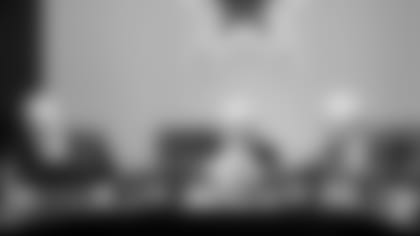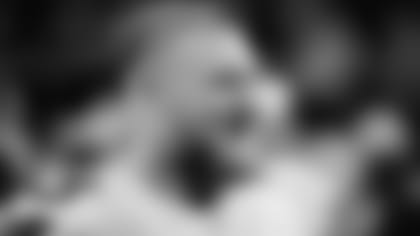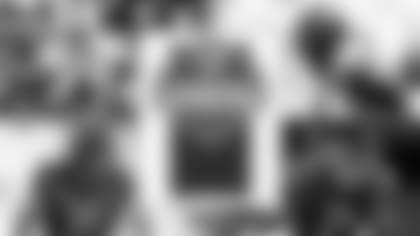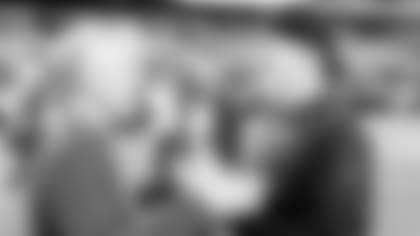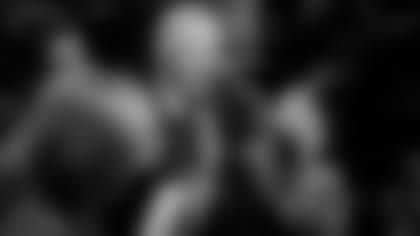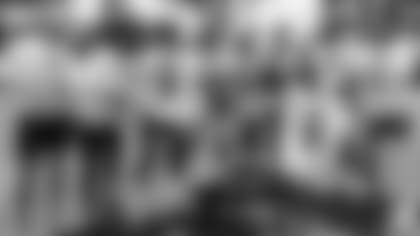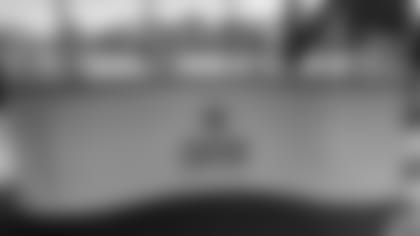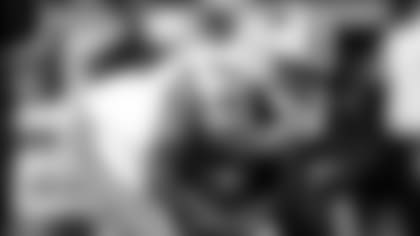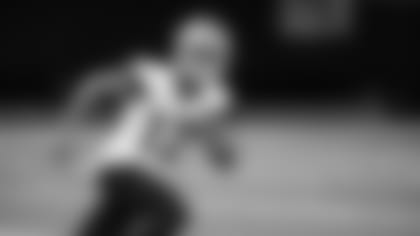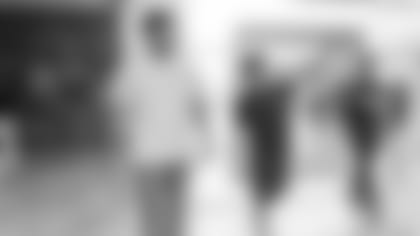The Cowboys' first practice facility in Dallas was so unimpressive that their first No. 1 draft choice almost didn't find it.
"I drove over from Fort Worth for a rookie orientation just before we went to training camp in Northfield, Minn.," TCU All-America defensive tackle Bob Lilly said. "When I got to Oak Cliff, I saw an old baseball field, but I couldn't see any way to get to it. I kept driving around and finally went down an old road, parked and walked in an open sliding door. Then I found a small meeting room where Coach [Tom] Landry was speaking.
"When I sat down, he said, 'You're late, Bob. We don't have a fine system in the offseason, but once training camp starts there will be a $50 fine if you're not in your chair on time. Then if it's repeated, the fine will double each time it happens."
One warning from Landry was enough for Lilly.
"My salary for my first year was $10,500," he said, chuckling. "I figured that fine could get up to $1,000 pretty quick."
That old baseball park was Burnett Field, a minor league relic on the banks of the Trinity River just across the Houston Street viaduct from downtown Dallas. Through the years it had been rented out for other athletic events. In the late-1940s, Dallas high school football B-teams played there on weekday afternoons. In November 1954, a few weeks after joining the sports staff of The Dallas Morning News, my first beat was covering the new Dallas Hornets semi-pro football team on lovely autumn Sundays. Some beat. The Hornets went broke after three games.
Burnett Field wasn't attractive, but it was available after the Cowboys franchise was founded on the fly in January 1960 by NFL club owners two months after the league's college draft for the next season. They were determined to field a Dallas team in September to compete with AFL founder Lamar Hunt's Texans. The Cowboys' first training camps that summer were in beautiful Forest Grove, Ore., and beastly Delafield, Wis. Since they had no place to practice in Dallas until September, they bounced around the country playing a patchwork six-game exhibition schedule. In one weirdo, they lost a 49-14 toughie to the Los Angeles Rams at a rodeo arena in Pendleton, Ore.
Settling in at old Burnett Field seemed like a nice idea – until they actually did.
The field sometimes flooded, forcing Landry to load his team on a bus and roam around looking for a school that would allow the Cowboys to work out on its field. They weren't always successful.
"We not only weren't America's Team then," marvelous little quarterback Eddie LeBaron laughingly recalled several decades later. "We weren't even Oak Cliff's team."
The training room was a lovely pink. It was the women's restroom during baseball season. After practice, the first guy in the shower enjoyed the only hot water. Lockers were scarce. Most players hung their stuff on wall-hooks. And they soon learned not to leave their sweat-soaked leather cleats on the floor. Rats chewed holes in them overnight.
"The rats were the most interesting things about the place," Lilly said. "Jack Eskridge (equipment manager) got some rat poison, but the rats ate it and just got bigger. He brought in traps and some pellet guns. That discouraged them a little, but they stayed with us."
Gil Brandt, original head of scouting and player personnel, put the Cowboys' first practice facility in perspective.
"Burnett Field was bad, but some clubs had worse," he said. "In Chicago, the Bears practiced in Lincoln Park for God and all to see.
"It wasn't the Taj Mahal like the place they've moved into now, but for that time, we thought Burnett Field was great. Jimmie Parker (business manager and previously assistant athletic director for the Dallas Independent School District) probably set it up. He was a Dallas old-timer. The rent? Whatever it was, it was found money for the baseball club."
In the spring of 1961, after the Cowboys' 0-11-1 debut season, they set up a small workout and treatment facility in the Hines Boulevard fieldhouse at P.C. Cobb Stadium, named in honor of the longtime DISD athletic director who was Parker's former boss. Players who lived in Dallas in the offseason used it occasionally. The fieldhouse was a nostalgic place for second-year quarterback Don Meredith.
In December 1954, Meredith was the sensation of the 32-team Dr Pepper High School Basketball Tournament there. The 6-3, 185-pound center, a tremendous shooter with either hand, set individual and tournament records of 52 and 164 points, respectively, as he led the Mount Vernon Tigers to the championship over larger and more talented schools.
But there was nothing nostalgic about Burnett Field's locker room.
"It was like a mining camp in the Old West," said Cornell Green, the Cowboys' first college basketball star who arrived as a raw rookie from Utah State in the summer of 1962 and would develop into a fine defensive back who would play 13 years. "It was impressive to see those rats in the cold water showers, too. The place was old and broken down, but some locker rooms around the NFL were, too. Kezar Stadium [San Francisco] was bad and Yankee Stadium was, too. The Cotton Bowl was pretty nice."
But wherever the Cowboys played, Green was a big asset. Fast, rangy and blessed with the keen reflexes of a fine basketball player, he made All-Pro four times, earned five Pro Bowl nods and became a nice piece of trivia.
Name three athletes who played in Madison Square Garden and Yankee Stadium in the same year. The answer: Gene Conley, Dave DeBusschere and Cornell Green. The others, however, were basketball players who made it in baseball.
Pettis Norman also was a rookie free agent in 1962, a wide receiver/tight end who had a strong impact on the Cowboys' future. Unlike Green, he came from a little-known school in North Carolina with meager facilities.
"For me, Burnett Field was kind of a graduation for a guy who came from Johnson C. Smith College," Norman said. "It was adequate. It was a place to practice. I really didn't think about anything special. I just concentrated on making the team."
In such tight quarters, a press workroom for interviews and writing didn't exist. When players were dressing after practice, I would invite a guy I wanted to interview to join me in my personal workroom – the cafeteria at The Dallas Morning News. When he was ready to leave, we met in the Burnett Field parking lot and he followed me across the Houston Street viaduct, a two-way thoroughfare then, to The News building at Young and Houston. I'd buy him a hamburger and a soft drink, then find us a table where I got my story.
Somehow, I don't think I could do that with today's multimillionaire players.
Frank Clarke, a speedy wide receiver from the Browns whom the start-up Cowboys selected in the NFL expansion draft in the spring of 1960, wasn't surprised by the team's practice site. He was accustomed to shabby facilities.
"The conditions at Burnett Field were quite similar to what we knew at old League Park where we practiced in Cleveland," Clarke said.
Lee Roy Jordan, the star Alabama middle linebacker and the Cowboys' No. 1 draft choice for 1963, felt a similarity to a much earlier practice site where he played high school football.
"It was not much better than Excel High School," said the pride of Excel, Ala., the little farming and ranching community (population 306 in the latest U.S. census) where he grew up. "I only had a few spring workouts at Burnett Field, then hallelujah! The Texans moved to Kansas City and we moved into their practice facility on North Central Expressway."
OK, please let this happy octogenarian continue guiding you through the years.
AFL founder and Texans owner Lamar Hunt, an unlettered third-string end at SMU in the mid-1950s and son of legendary oil billionaire H.L. Hunt, had a nice practice field for his team and built a neat little facility beside it containing a locker room, training room and meeting rooms. The complex sat on an expanse of prairie just east of North Central Expressway between Mockingbird Lane and Yale Boulevard. It was where Lamar during his SMU days in the 1950s operated Zoom-A-Bat, an entertaining game where folks paid their money to whack baseballs. Interestingly, Lamar leased the property from Clint Murchison Jr., future owner of the Cowboys.
When Lamar gave up Zoom-A-Bat for grander projects, he used the land to erect an attractive facility for his pro football team. Attractive? It looked like a palace compared to what the Cowboys were stuck with (sometimes literally) in Oak Cliff.
So when the Texans became the Kansas City Chiefs, Clint bought out Lamar's lease on the practice field, purchased the building, and his Cowboys moved in. Murchison then opened Expressway Tower, a high-rise office building at North Central and Yale, and the facility was moved a block or two north and reopened on property behind Expressway Tower, where the club offices had relocated.
"That locker room was adequate, but very tight," Green said. "There were no secrets. If you said anything, everybody heard it. A telephone booth offered more privacy."
"We met, dressed and practiced right behind Expressway Tower," Jordan said, "so it was very convenient for Coach Landry and his staff to come down from their offices. They made it in about three minutes."
That location, tight as it was, stirs fond memories. The Cowboys practiced there for four seasons, 1963-66, when the team grew into champions. Walt Garrison never forgot the first day he walked in there in August 1966, a proud rookie fullback.
"When we got back to Dallas in late summer after training camp I thought I was hot stuff because I had a new car that the Cowboys had given me," Walt said. "I walked in our little locker room behind the club's office and said, 'Where's my locker?'"
Walt looked around and found something unusual at the end of a row of lockers.
"Don Meredith had two lockers with his name on them and next to them my name was pasted on the wall with my pads and stuff piled in front of them. He told me, 'There weren't enough lockers, but someone will get cut soon and you'll get one. I've got two lockers and you can use one of mine, but just hang your clothes in there, not any of your sweaty football stuff.' There wasn't a stool for me to sit on, but at least I had a place to hang my clothes.
"Well, on the third day I found out that Meredith had taken my name off one of those lockers, stuck it on the wall, then made another nametag for himself and put it on that locker. So for three days I had dressed standing up and thought Meredith was such a sweet guy, letting me hang my clothes in his locker when it was my locker all along."
But Walt still had more to learn in that locker room.
A few weeks later, he was pleased when Dan Reeves asked if he would sub for him at an appearance so he could accept a more lucrative one.
"I got $250 and a free meal, and Reeves took one for $1,000," Walt said. "I told Meredith about it, and he said he usually got $1,500 or $2,000. I said, 'Damn, Meredith, when you charge that much you don't get as many.' And Meredith said, 'Walt, when they pay you that much you don't need as many.' I did the math, and sure enough, he was right."
Walt treasures so much what he learned from Dandy Don.
"He taught me a lot about people, he taught me a lot about life, he taught me a lot about football," said Garrison. "They all went together in his life."
January 1967 was a time for historic events.
On New Year's Day, the Cowboys missed winning a trip to the first Super Bowl when their tremendous late rally against the NFL champion Packers ended 2 yards short of sending the title game into sudden-death overtime. Green Bay won, 34-27, but the Cowboys won a lot of hearts across America that day.
Soon afterward, the team moved northeast from that cozy place behind Expressway Tower to an upscale fieldhouse and practice facility on Forest Lane, one block west of Abrams Road.
"The Cowboys were ahead of the curve with that one," Green said.
Jordan agreed.
"The Forest Lane locker room was a step up," he said. "It was much larger and our lockers were arranged in position order – linebackers together, quarterbacks together, etc. We had plenty of space in the building for coaches' quarters, meeting rooms, training room, showers and sauna and a large equipment room.
It was such a modern fieldhouse that it had a stereo system. The first time I walked in, I heard Bobbie Gentry singing "Ode To Billy Joe," a hit song then. I don't know if it was still in the musical mix on Forest Lane six years later when the Cowboys' No. 1 draft choice was tight end Billy Joe Dupree, a Michigan State star from Louisiana.
"We had a nice blue fence around the practice field, which we thought gave us privacy," Jordan said. "But after a motel went up behind it a few years later, Coach Landry discovered the Redskins spying on our workouts. After that, our club rented all the upstairs rooms overlooking the field on practice days."
There was always a happy hum inside the fieldhouse in the early years there.
"It was a fun time," Jordan said. "We had the comedian of all comedians, Don Meredith. He quarterbacked an explosive offense and Coach Landry loved to confuse defenses by putting in innovations. Then there was the Doomsday Defense. We had a lot of greats through the years: Bob Lilly, Chuck Howley, Mel Renfro, Cornell Green, Cliff Harris, Charlie Waters."
And, of course, an All-Pro MLB with the initials LRJ.
That Forest Lane layout was a fertile place. By the time they left there for Valley Ranch 18 years later they had won two Super Bowls, barely lost three others and were universally acclaimed as America's Team.
All those greats had moved on when rookie free agent cornerback Everson Walls arrived in 1981, but there still was plenty of championship talent. He was almost a neighborhood guy. He grew up in Hamilton Park, a few miles north of Forest Lane and played at Richardson Berkner High School before then starring at Grambling, where he led all of college football with 11 interceptions as a senior. Angry that the Cowboys paid him only a $1,500 signing bonus, Walls was determined to show them they should have treated him with more respect.
Well, he certainly did.
He led the NFL in 1981 with 11 interceptions, still the club record, and made his first of four Pro Bowls. He grabbed 33 more in his next eight Dallas seasons and was the NFL leader again in 1982 and 1985. He was the youngest player named to the Cowboys' 25th Anniversary Team and ultimately the All-Time Cowboys Team. He also made the NFL's All-Decade Team for the 1980s.
Walls' first four years with the Cowboys were the team's last four on Forest Lane and he has fond memories of that locker room, particularly the back row.
"Ron Springs called it 'Ghetto Row' and it was always full of excellent performers," he said. "Ron, Tony Hill, Tony Dorsett, Robert Newhouse, 'Too Tall' Jones, Billy Joe Dupree, Dennis Thurman and Jay Saldi were very proud they lockered there. Saldi was the only white guy. He hung around with the brothers. Michael Downs (rookie free-agent safety from Rice and South Oak Cliff who also made the starting lineup in 1981) and I had lockers in the suburbs on the next row."
That was close enough to catch the action and chatter on Ghetto Row, where Springs was the self-appointed mayor.
"One day Jay (6-3, 225-pound tight end) got into some kind of argument with a young guy, Wade Manning (5-11, 190-pound WR/DB and former Ohio State baseball star and Big Ten MVP). Suddenly, wham! Manning body-slammed Jay. While he was down there, trying to figure out what happened, Ron grabbed a can of baby powder and outlined Jay's body."
But Ron Springs also was a realist.
In the spring of 1985, the entire Cowboys organization went to Irving for a walk-through tour of the elegant new Valley Ranch facility that would be the team's new practice site when it returned from training camp in Thousand Oaks, Calif., in August.
"Everyone was impressed by the beautiful new facilities," Walls said. "But Ron told Doug Donley, 'Don't worry, Doug. We'll never be here.' He was right. They were traded before we left camp."
President and general manager Tex Schramm, Murchison's first hire in 1959, months before the Cowboys were awarded an NFL franchise, oversaw the construction of the spectacular Valley Ranch complex. It was state-of-the-art then, just as the Forest Lane complex was state-of-the-art when it opened in 1967. Valley Ranch remained so for much of its 31 years and for a while also proved tremendously fertile for producing world champions. Owner Jerry Jones and family, who took over in 1989, can always cherish the memory of winning three Super Bowls in four seasons (1992, 1993, 1995).
But Valley Ranch is vacant and the Cowboys have moved into even more spectacular facilities in Frisco for the 2016 season. Let's see if the club can now regain its long-missing championship ability at The Star.
"Just like the stadium in Arlington, the new facilities in Frisco probably are the finest in the world," Roger Staubach said. "I toured the complex several weeks ago and it's an impressive evolution from what we once had. That Baylor Scott & White health facility is a great addition. You can have analysis, treatment and rehab without ever leaving the building.
"In free agency today, this type of facility has added importance. You have to do these things to appeal to the free agents you're trying to sign."
The Star at Frisco spread-eagles all facilities before it in Cowboys history, and Cornell Green isn't surprised.
"You can't compare changes from then to now," he said. "It's a different world."
(This story originally appeared in Dallas Cowboys Star Magazine.)
There will be a "Celebration of Dave's Incredible Life" on Saturday, Dec. 17, at noon at Flagpole Hill in Dallas. Fans are invited to dress up or come casual (Edwards hated dressing up). Music will be played and stories will be told with art, game balls and other memories of Edwards' life there to see.



